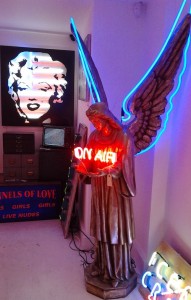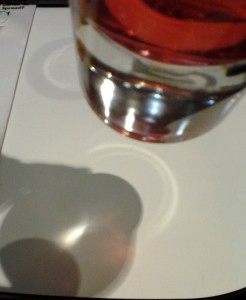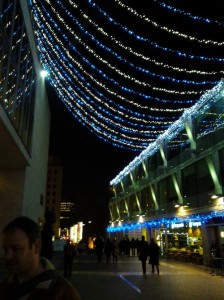 I met back up with Manar for a midday adventure. After considering ice skating, we decided to view Shoot: Existential Photography at the Photographer’s Gallery. (For those of you who don’t know my past lives, from 1996 to 1999, I worked at University Galleries. I curated a show called Text and Territory: Navigating Immigration and Dislocation which include works by David Wojnarowicz and Julie Mehretu among others. My best friend runs Art2Art which curates traveling photography exhibitions for museums.)
I met back up with Manar for a midday adventure. After considering ice skating, we decided to view Shoot: Existential Photography at the Photographer’s Gallery. (For those of you who don’t know my past lives, from 1996 to 1999, I worked at University Galleries. I curated a show called Text and Territory: Navigating Immigration and Dislocation which include works by David Wojnarowicz and Julie Mehretu among others. My best friend runs Art2Art which curates traveling photography exhibitions for museums.)
Manar and I walked from Covent Garden to Oxford Circus area. On the walk, we found a neon store! I particularly loved this angel on air.
We also came across this odd sign about William Blake. I had no idea he was born the day before me (okay, 200 years before also).
 Oddly we came upon a gallery that I recognized. Why? Because Bill and I had walked past it on the evening of the 27th. And looking in the window at the cafe, Bill had remarked that he knew the gallery had moved and now he had discovered where it had moved to! And here we were! Yeah! Adventure on!
Oddly we came upon a gallery that I recognized. Why? Because Bill and I had walked past it on the evening of the 27th. And looking in the window at the cafe, Bill had remarked that he knew the gallery had moved and now he had discovered where it had moved to! And here we were! Yeah! Adventure on!
So, Shoot: Existential Photography, showed photos of people shooting themselves. There are shooting galleries where you shoot a target, which triggers a camera to take a picture of you shooting. One woman had taken pictures of herself over a 70 year period. You could see the evolution of her life and of photography (as film quality changed). There is something pretty disturbing about many of the images – the idea of shooting a photo and shooting yourself with a gun merged.
There was also a video room with a remix of hollywood film shots of people shooting. The soundtrack to that was pretty danceable. I tried to stand a bit in the corner so I could de-focus my eyes and see all four screens at once. Again, this was very disturbing. Throughout the show I had the sense that I had never before and hopefully never again have so many guns aimed at me.
I know it sounds a bit odd to want to see such things, but as I wrote yesterday, our relationship with self and death is important to being present to living and aliveness. We must not, I believe, hide from our own mortality. We can embrace it.
On our walk, we started talking about the new series I want to launch on the agency: Play Your Way. And this quickly segued into a discussion on gaming. From there, we talked about Jane McGonigal. She had developed a game when she suffered a concussion (see her ignite talk on it). She did research, around this time, on post-traumatic growth: those ways we grow after a near death experience. I had never heard of post-traumatic growth, so I was eager to hear more! Turns out, I understood more than I expected. This is the awakening or aha process that I had worked on in my early years in philanthropy. When people wake up to their mortality, and realize they have enough for themselves, they become more philanthropic. We had wondered in 2004-2005, how to trigger that without having to have the jarring experience of near-death trauma. Well, in post-traumatic growth, people also focus more on experiencing versus having, high quality connections, etc. Do we have to come close to our own death to realize this and align our lives? I don’t think so, I think we can walk towards it through awareness. And this is a good part of why I went to Death: A Self Portrait and Shoot.
What is it to fully experience living in the face of our own mortality? What must we do today to avoid the regrets of our deathbed? What do I need to complete now in order to be more fully present to my livingness? How do I step into my 40s with deep clarity of my purpose, connection, meaning, and live a life of thriving?
Whew, a lot to reflect on. Deep breath. After the exhibit, we went for a quick lunch and chat. I had a Lord Byron burger. Mmmm.
In the evening, I met with Benjamin Ellis and then later Cassie Robinson joined us. I met Benjamin at sxsw in 2010 through Arie Moyal. When I talk with Benjamin, as with many of my most brilliant friends, I have these huge mindgasms. I think we went from 0 to 60 in 15 seconds.
Since 2005, I have wanted software that does data visualizations of social network maps with venn diagrams. Benjamin explained why these maps are not made currently, and we worked on how we could actually make them and what they would be useful for. We talked a bit about what I have called relationship physics, where you can see social network maps change over time as a group converges or boundary spanners explore and connect. I have some rough maps of these which I should post about soon.Then I asked if you could make those maps move through time. He clarified that often people will change how they gather data, so when you get jumps in the maps you would have to be sure that it was because the reality changed and not the data sourcing.
Then I asked if you could have yet one more layer – looking at how they are working on purpose. Think of a social network map…and then you start to zoom out and see the venn diagram of groups within the network held together by a seemingly invisible gravitational core (and idea or purpose), then put the map in motion and see if that gravitational core can be mapped as actions are taken. I am thinking a mashup of SNA with gapminder… what people and groups are working or have worked on millennium development goals and what has that achieved? Benjamin made clear why this would be difficult if not impossible and perhaps evening meaningless to do.
It is as if I am trying to make two slices of the world condense into one and the ability to gather the right data would be next to impossible. 7 years of trying to imagine this, and in one evening, I am making huge leaps in understanding what can and can’t work in very practical ways from a guy who is doing visualization and data collection. Mindgasm.

Organizational Topography
Then Cassie joined us, and Benjamin and I tag teamed on catching her up on what we had discussed pulling out page after page of hand-sketched pictures. We discussed the Action Spectrum and how it relates to these maps and venn diagrams with the multi-membrane organization model. And we talked about the corporate shift from hierarchy to network and the need for a more useful model for decision making than flat networks. I drew a 2D version of the network topography that has been in my head since 2009.Imagine taking a tiers of a hierarchy map and making each tier one bar height of power or influence. Each node in the network doesn’t have a static bar height the way old hierarchies seemed to. By project or even phase of project that bar height can change. Then imagine that proximity of connection is not by department but by social interaction count, so you are placed closest to those that you interact with most, the way you are in a social network map. We talked about some of the myths of flatness in open source that misled a lot of corporations into flattening their structures without being mindful of decision making compromises.
We also talked about organizational structures not fitting the organizational models that we feel drawn to. I am curious to see how we will change these structures legally to better fit the relationships and accountability we want to have.
After Cassie and I left Benamin outside the Royal Festival Hall, Cassie and I went for sushi, caught up as friends and called it a night. I am so lucky to have met Cassie. She amazes me with the quiet work she does in the world. Grounded, network weaving, transformative, and heartfelt. Thank you Cassie.
Thank you!!! So grateful for the amazing day!





1 pings